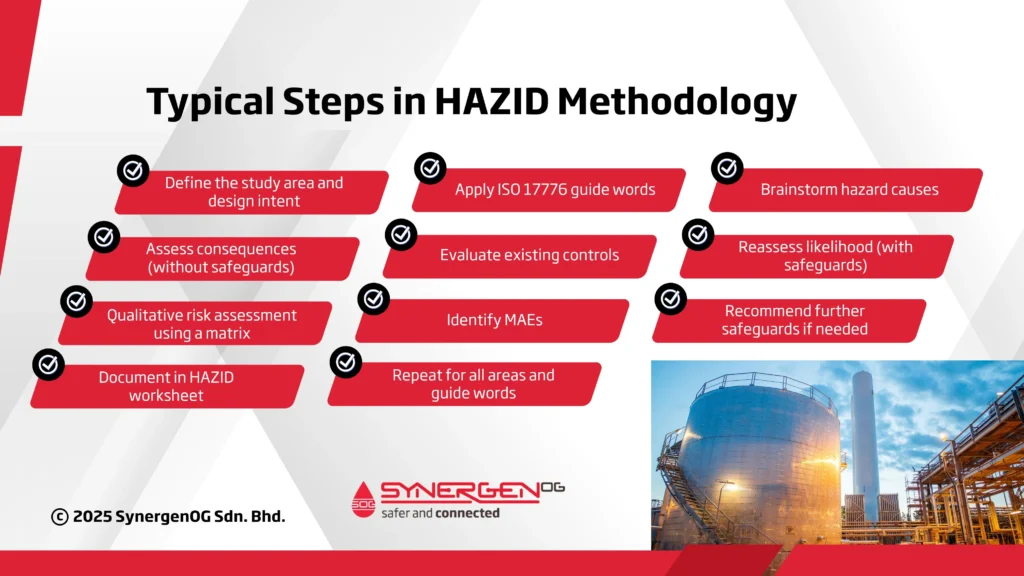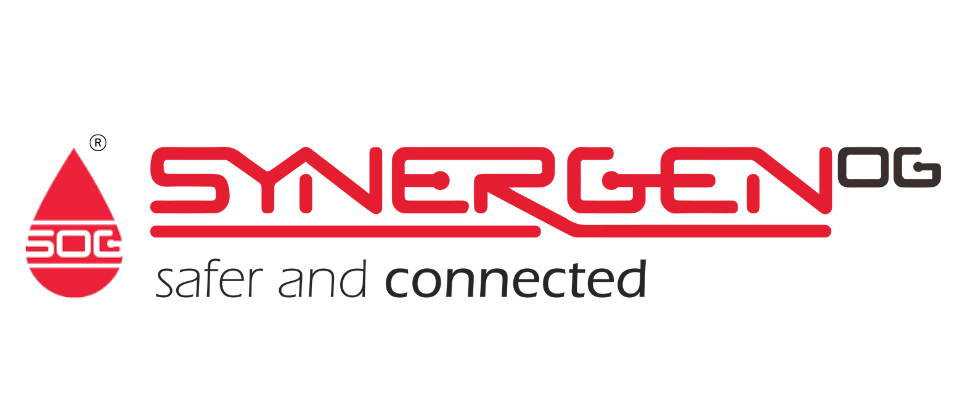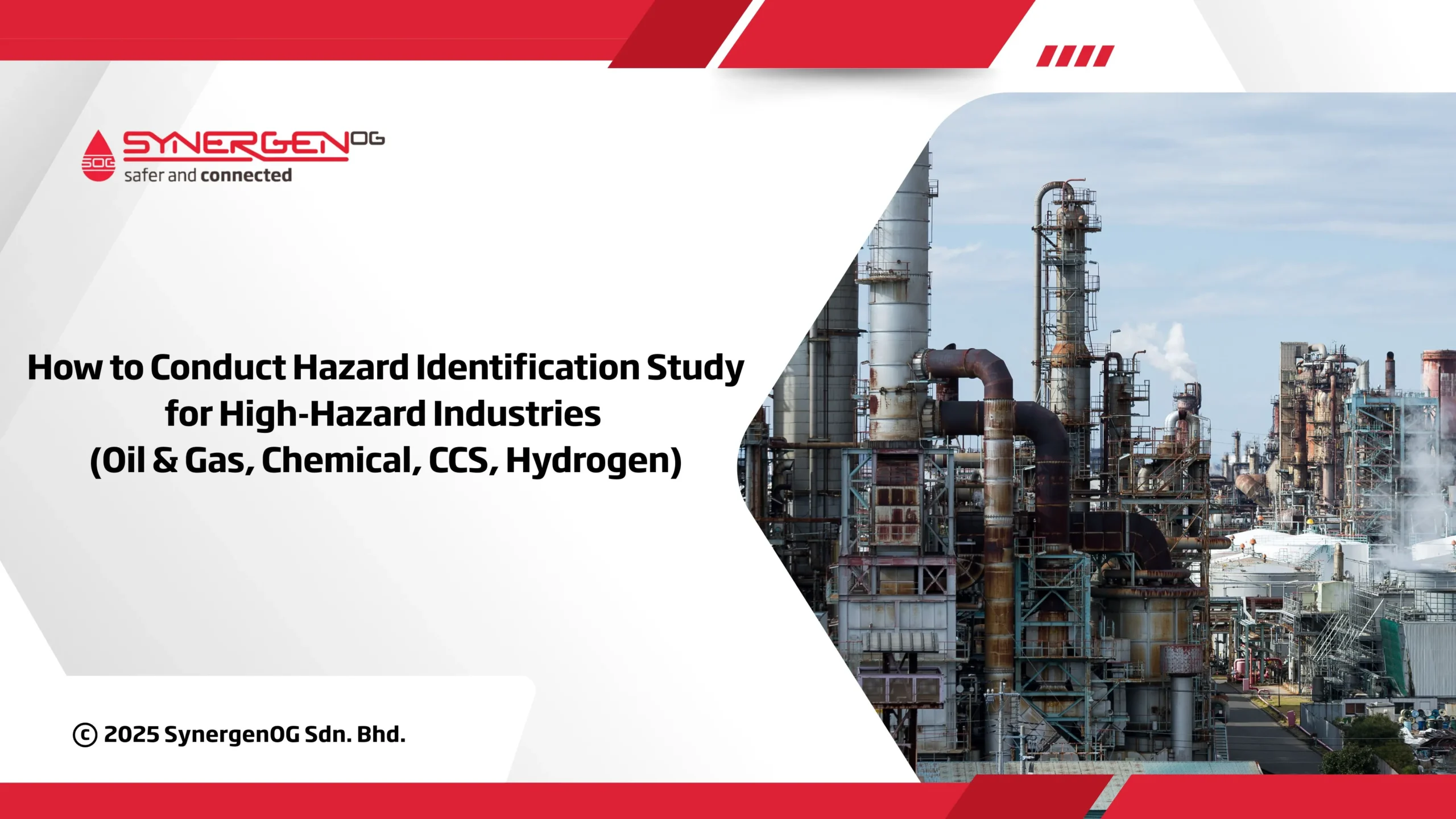| Summary: Before risks become realities, they exist as overlooked details in design and operation. A Hazard Identification (HAZID) study is not just a checklist—it’s a focused inquiry into how things might go wrong and what that truly means. This blog breaks down the HAZID process into its core mechanics: from defining intent and applying ISO 17776 guide words, to exposing causes, testing controls, and isolating Major Accident Events. It’s a methodology built for those who don’t accept assumptions at face value—engineers, designers, and safety professionals who know that what you prevent never makes the news. |
In industrial sectors like chemical manufacturing, oil and gas operations, hydrogen energy infrastructure, and carbon capture and storage (CCS), the cost of missing a hazard can be catastrophic. Explosions, toxic releases, structural failures, and environmental damage are all potential outcomes when hazards are not properly identified and managed.
That’s where HAZID (Hazard Identification) comes in. The primary goal of a HAZID study is to systematically identify what could go wrong before operations begin, enabling teams to implement controls before risks materialize.
Globally, regulations such as OSHA’s Process Safety Management (PSM) standard, the European SEVESO III Directive, and EPA’s Risk Management Program (RMP) require hazard identification as part of a facility’s overall risk management strategy. But beyond compliance, HAZID also protects workers, assets, and corporate reputation.
What is Hazard Identification (HAZID)?
A HAZID study is a structured, qualitative analysis that identifies potential hazards within a defined scope, be it a single system, equipment skid, or entire facility.
A HAZID study identifies credible hazardous events within a defined scope (e.g., a process unit, chemical storage area, or pipeline). It focuses on the nature, cause, and consequence of potential incidents.
Unlike more detailed techniques like HAZOP (Hazard and Operability Study), it doesn’t explore every process deviation but instead captures broader risks like equipment rupture, overfill, misoperation, and natural hazards.
Read: HAZID Vs HAZOP: Which one to choose & When
When should you conduct a HAZID?
- During Conceptual or FEED (Front-End Engineering Design): Early in a project’s lifecycle, when you can still influence design choices and layout decisions, is the ideal time to conduct a HAZID.
- During Major Changes: Equipment upgrades, expansion projects, or procedural changes can introduce new risks.
- Following Near Misses or Incidents: If something almost went wrong—or did—you should reassess what was missed in the original hazard review.
- Every 3–5 Years: Regulatory frameworks such as OSHA’s Process Safety Management (PSM) standard mandate regular updates to hazard reviews.
The methodology encourages team brainstorming using guidewords such as fire, leak, overpressure, or external threat to trigger thought processes. It takes into account hazards related to chemical properties, equipment design, human interaction, and environmental factors.
Hazard Identification (HAZID) Methodology
Step-by-Step Execution

Typical Steps in HAZID Methodology
● Define the study area and design intent
● Apply ISO 17776 guide words
● Brainstorm hazard causes
● Assess consequences (without safeguards)
● Evaluate existing controls
● Reassess likelihood (with safeguards)
● Qualitative risk assessment using a matrix
● Identify MAEs
● Recommend further safeguards if needed
● Document in HAZID worksheet
● Repeat for all areas and guide words
HAZID (Hazard Identification) methodology is a structured and systematic process used to identify potential hazards in the design, construction, and operation phases of a facility. Based on ISO 17776 guidelines and the HSE Basis of Design, HAZID involves a combination of brainstorming, analysis, and team experience to ensure early detection of risks.
Let’s look into detail.
1. Preparation Phase
a. Define the Study Area and Design Intent
Establish the scope, objectives, and boundaries of the HAZID study (e.g., entire processing unit, hydrogen blending skid, or specific equipment).
Clarify expected outcomes and deliverables to prevent scope creep and ensure alignment.
b. Gather Relevant Documentation
Collect essential documentation including:
- Process Flow Diagrams (PFDs)
- Piping and Instrumentation Diagrams (P&IDs)
- Material Safety Data Sheets (MSDS)
- Plot plans and equipment layouts
- Safety system designs (e.g., interlocks, shutdown systems)
- Incident, near-miss, and audit histories
c. Assemble Multidisciplinary Team
Select a team with diverse expertise to ensure comprehensive hazard identification, including at minimum:
- Facilitator: Experienced, impartial HAZID leader
- Process Engineer: Technical expert on the process design
- Operator/Technician: Practical operational insights
- HSE Specialist: Regulatory and risk assessment expert
- Maintenance Engineer: Knowledgeable in equipment reliability and maintenance practices
- Instrument Engineer: Expert in instrumentation, alarms, and safety systems
d. Conduct Introductory Briefing
The facilitator provides an overview of the HAZID methodology and expected process, ensuring all team members share a common understanding.
The Project or Process Engineer outlines the facility’s operations and project objectives to orient the team.
2. HAZID Review Process
a. Apply ISO 17776 Guide Words
- Systematically use ISO 17776 guide words (e.g., Leak, Rupture, Utility Failure, Human Error, External Events) to prompt structured identification of hazards in each node or area.
b. Brainstorm Hazard Causes
Team identifies credible scenarios through structured brainstorming, considering:
- Equipment failures (e.g., valve leaks, pump seal failures)
- Human error (e.g., operator mistakes during startup/shutdown)
- External events (e.g., weather, vehicle impacts, cyber threats)
c. Estimate Inventory for Hazardous Materials
Evaluate and document the quantities of hazardous substances involved in each identified scenario, considering:
- Static inventories (vessels, storage tanks)
- Dynamic inventories (piping, recirculation loops)
d. Define Release Parameters
Clearly define conditions for each potential hazard scenario, such as:
- Pressure and temperature conditions
- Phase (gas, liquid, two-phase)
- Release rate and duration
Consider specific examples, e.g., high-pressure hydrogen tank release scenarios.
e. Assess Consequences (Without Safeguards)
Identify potential hazardous outcomes including:
- Fires (pool, jet, flash fires)
- Explosions (VCE, BLEVE, deflagration)
- Toxic releases
- Asphyxiation scenarios
- Environmental impacts
Utilize consequence modelling tools (e.g., DNV PHAST, ALOHA) to determine severity and extent of potential impacts.
f. Identify Congested Areas
Highlight plant areas where congestion may amplify hazards (e.g., limited dispersion, explosion escalation, obstructed escape routes).
Recommend additional safeguards, such as blast walls, re-routing escape paths, gas detection systems, or relocation of critical infrastructure (e.g., control rooms).
g. Evaluate Existing Controls
Document and critically evaluate existing safeguards including design features, safety systems, interlocks, alarms, and operating procedures.
h. Reassess Likelihood (With Safeguards)
After assessing existing controls, reassess the likelihood of each hazard scenario occurring.
i. Qualitative Risk Assessment Using a Matrix
Perform qualitative risk ranking using a standard 5×5 or 4×4 risk matrix, incorporating:
- Likelihood ratings based on historical incident data and equipment reliability.
- Consequence ratings from consequence assessment.
j. Identify Major Accident Events (MAEs)
Identify scenarios with potential for severe consequences (MAEs), requiring special attention or enhanced controls.
k. Recommend Further Safeguards if Needed
Identify gaps or areas where risks remain unacceptably high. Recommend additional safeguards, such as:
- Design modifications
- Enhanced instrumentation and alarms
- Administrative controls (operational procedures, training)
- Emergency response improvements
Need to assign clear ownership, timelines, and mechanisms for action closure.
3. Documentation and Reporting
Document in HAZID Worksheet
Systematically record all identified scenarios, hazards, risk assessments, existing safeguards, recommendations, and responsible parties in a structured HAZID worksheet.
Finalize HAZID Report
Produce a detailed report capturing:
- Objectives and scope clearly defined
- Participant list and their roles
- Methodology and guidewords applied
- Comprehensive risk register detailing identified hazards, consequences, and risk rankings
- Recommended actions, responsibilities, and due dates
- Summary and conclusions highlighting key findings, particularly MAEs
This report becomes part of the Process Safety Information (PSI) required by OSHA and forms the basis for further studies like HAZOP, LOPA, and QRA.
4. Repeat the Process
Repeat steps systematically for all defined nodes, systems, areas, or process sections using the established methodology and guidewords until comprehensive hazard identification is complete.
Regulatory Mandates and Industry Standards for HAZID Study
HAZID is directly supported or implied in several global safety standards, such as,
- OSHA 29 CFR 1910.119 (PSM): Mandates Process Hazard Analysis for covered processes
- EPA 40 CFR Part 68 (RMP): Requires worst-case scenario planning and hazard review.
- SEVESO III Directive (EU): Mandates major accident prevention documentation
- ISO 45001: Requires hazard identification and risk control
- IEC 61511: Emphasizes hazard identification for Safety Instrumented Systems
- API RP 752/753: Provides guidance on facility siting and human exposure risk
Common Missed HAZID Elements across Recent Major Accidents
1. Hazard of human error during routine maintenance
Routine maintenance tasks often overlooked in hazard reviews can introduce significant risk due to human errors, such as incorrect valve positioning or failure to follow procedures precisely, leading to severe incidents.
2. Non-routine operations and temporary states not evaluated
Temporary configurations (e.g., equipment bypasses, startup, or shutdown phases) often escape scrutiny during standard HAZID assessments, yet these scenarios frequently trigger incidents due to reduced or disabled safeguards.
3. Aging equipment and deferred maintenance risks
Equipment degradation from age, corrosion, or deferred maintenance is frequently underestimated, with risk assessments neglecting how reliability issues escalate potential hazards.
4. Lack of bowtie or LOPA studies to assess controls and escalation factors
Without rigorous analytical tools such as Bowtie diagrams or Layers of Protection Analysis (LOPA), critical safeguards and potential escalation pathways may remain inadequately understood or addressed.
5. Interface risks in contractor-involved work
The introduction of contractors can create interface gaps, where responsibilities and communication break down, increasing the likelihood of errors, misunderstandings, and resulting accidents.
Conclusion
A well-executed HAZID study is not just a compliance exercise—it’s a cornerstone of responsible engineering. It helps design safer facilities, prepare teams for emergencies, reduce insurance and liability exposure, and—most importantly—save lives.
To maximize its effectiveness:
- Integrate HAZID early in the project
- Involve diverse, experienced teams
- Use the results to inform detailed analyses and design decisions
- Treat it as a living document, updating it with every major change
In the end, a properly structured HAZID process reflects a company’s true commitment to operational excellence and human safety.

